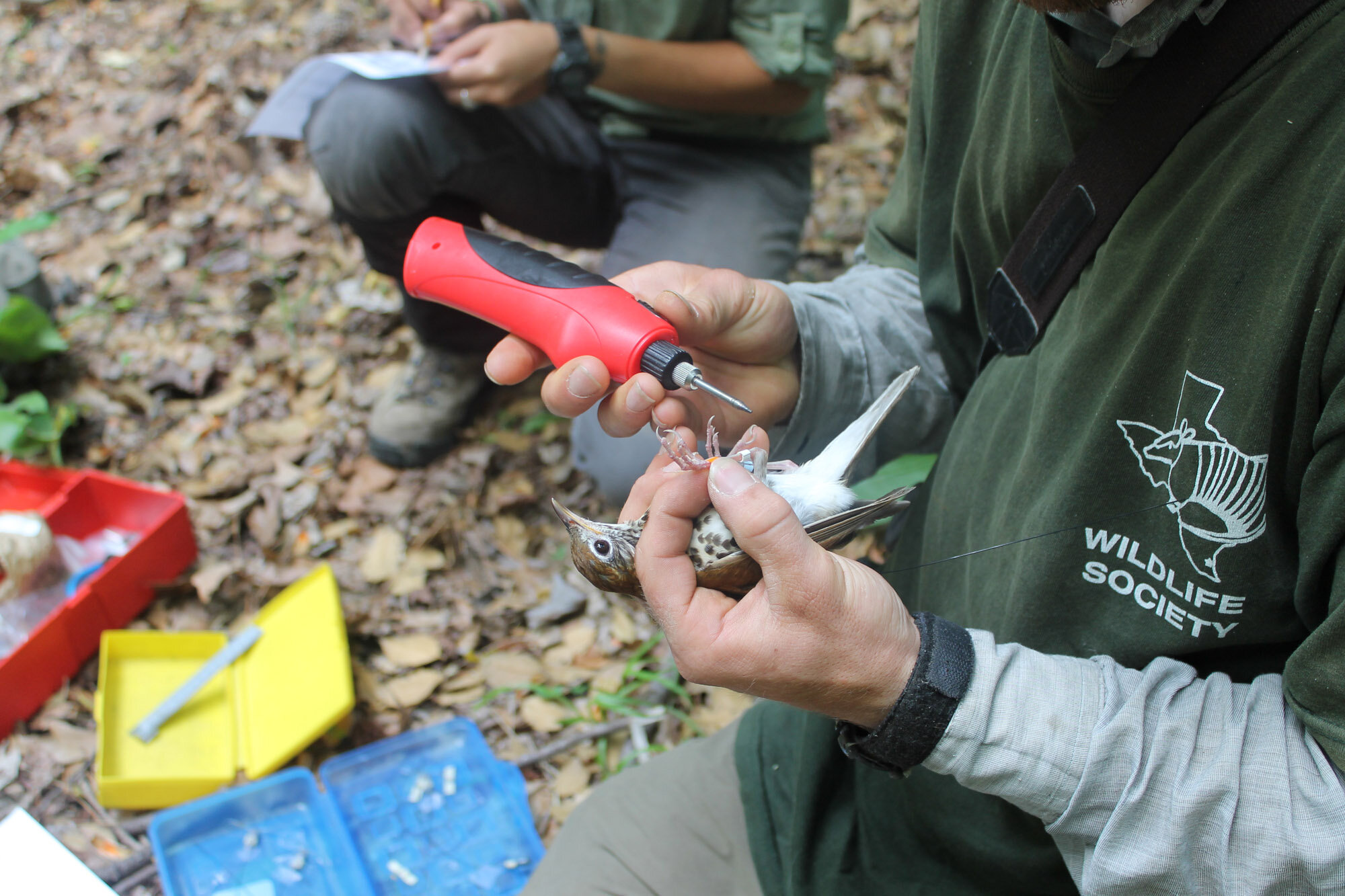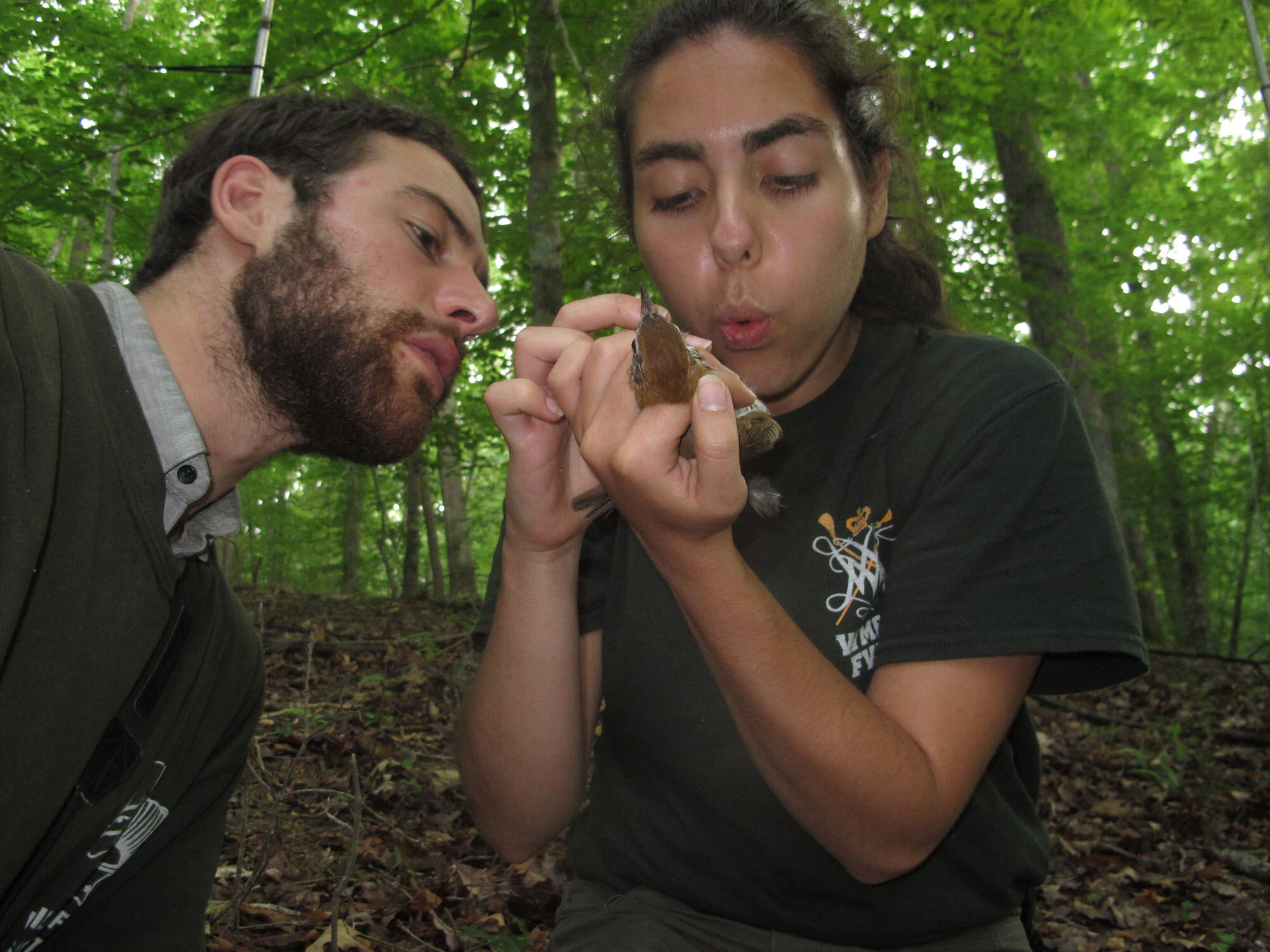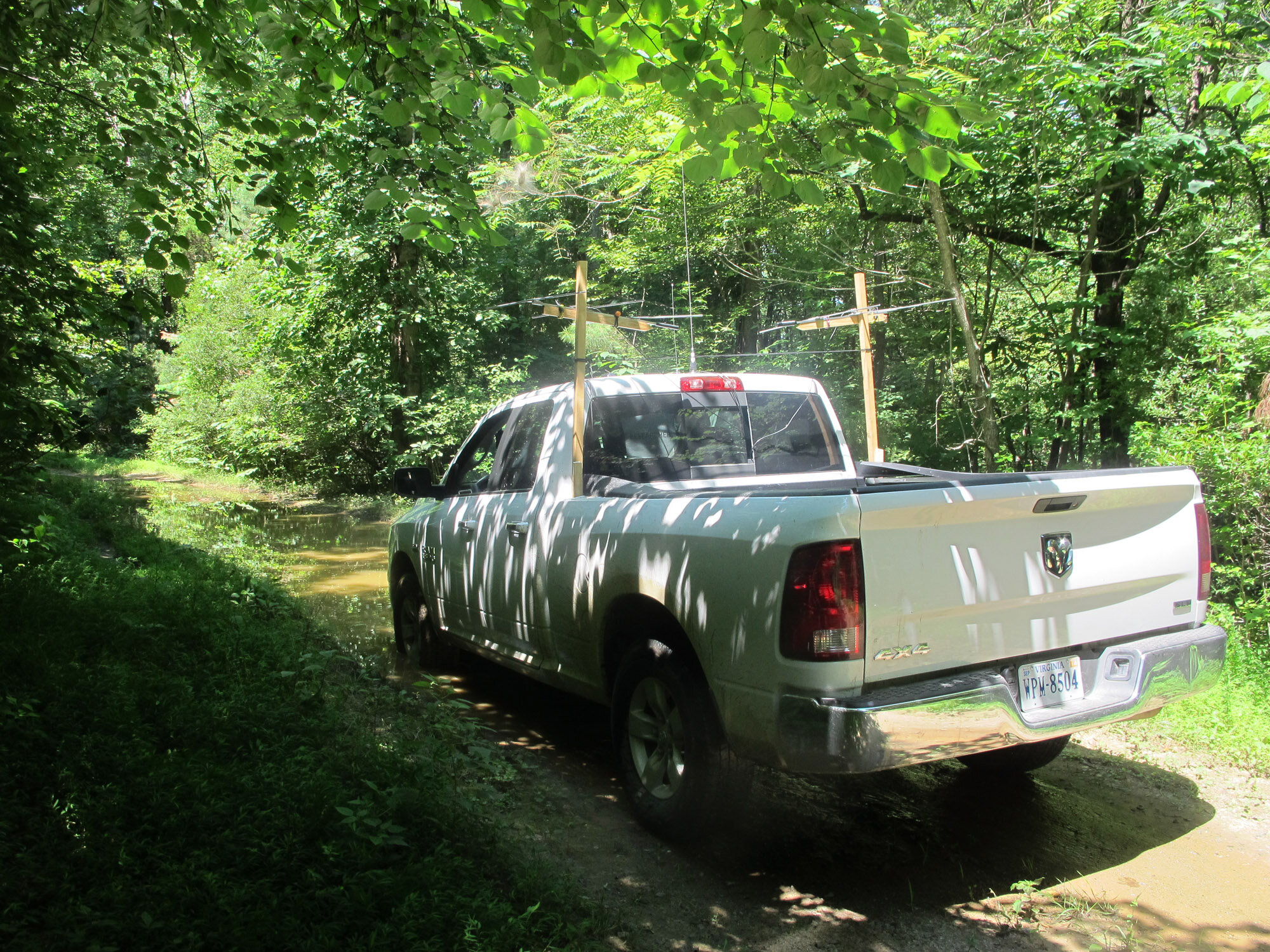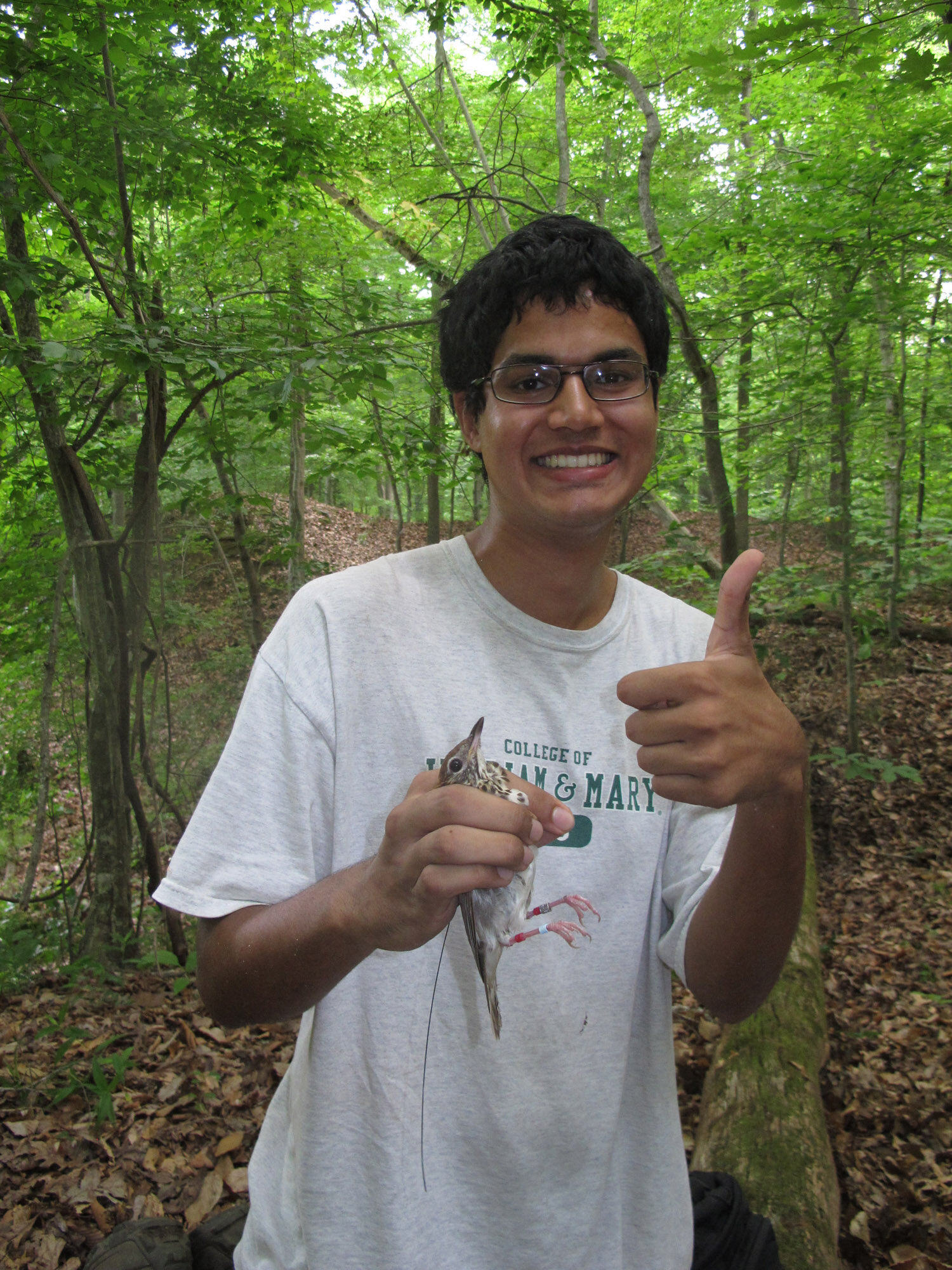
“PROJECTS > Wood Thrush”
Wood Thrush movement in Virginia
Collaborators: Matthias Leu, Robert Isdell, Chris Smith, Christina Varian, Jonathon Valente, et al.
Duration: 2012 to (ongoing)
The Wood Thrush (Hylocichla mustelina) is frequently a species of interest. This attention is due in part to its distinct song (and thus popularity) and association with tracts of mature forest (and thus ties to conservation as an indicator or umbrella species). Together with Matthias Leu as the advisor, I developed a project dedicated to studying Wood Thrush movement ecology on their breeding grounds in Virginia, where I worked on my MSc degree at the College of William & Mary. This study was principally funded by a SERDP grant to Matthias, along with a number of smaller grants I secured from non-profit organizations (see Acknowledgements in papers).
The main objective was to follow radio-tracked individuals to answer several questions related to their movement. The project’s field component occurred in 2013 and 2014, and in May of both years, I placed radio transmitters on birds and small teams of technicians tracked them throughout the breeding season—mostly in June and July. The study area on the Virginia Peninsula is a mosaic of land ownerships, which presented a few challenges regarding permits and field logistics. For example, we quickly realized that Wood Thrushes do not heed the current dogma that migrants should establish a static breeding territory. Within a couple of weeks after tagging, many birds picked up and left their original home ranges in Park A to set up a new one in Park B without regard for my months obtaining permits to work in A. This behavior was problematic especially because many of the study sites were flanked by US Department of Defense property, including the Naval Weapons Station Yorktown and Camp Peary that notoriously hosts a covert CIA training facility known as “The Farm”. On top of this, even re-locating birds following shifts was a pain, to say the least. Radio transmitters for Wood Thrushes need to be small and light, which meant that, in the lush foliage of the eastern deciduous forest, the signal petered out at 300–600 m. Because birds often moved several kilometers, finding them again required a major effort for which I rigged our field truck with double Yagi antennas and a backpack with a whip antenna to cover off-road areas on my mountain bike. Even then many birds remained at large, so the Center for Conservation Biology connected me with the pilot for their annual surveys of breeding Bald Eagles in the Chesapeake Bay. As his name suggests, “Captain Fuzzzo” was a character and exactly the right person for the job. A former fighter pilot, Fuzzzo seemed to have lost little spunk by his 70s—we rigged the telemetry gear to his Cessna 172 and off we went with systematic searchers from the air, unburdened by fences, POSTED signs, and thick vegetation. Fuzzzo had no qualms about flying over Camp Peary or the Weapons Station, both of which we quite literally buzzed, even finding one of the missing birds. With the help of Fuzzzo, field trucks, and biking, we managed to relocate most of the missing birds and after negotiations and paperwork, were able to complete data collection for birds in the new locations (even at the Weapons Station—thanks to US Navy and likely my link to DoD through SERDP).
Where do Wood Thrushes sleep?
I published my first scientific paper on roosting behavior of birds. Since then, following birds to their nocturnal sleeping locations became “my thing” that I inserted into any project I could. As for most other species, this aspect of Wood Thrush ecology was unstudied, so I did not hesitate to add roosting to the list of topics that comprised my thesis. Thankfully, my graduate committee (Dan Cristol & John Swaddle) was supportive.
The field task to studying bird roosting was simple—find them at night just as they were found during the day. But the execution was less straightforward, because, as we found with this effort, birds moved on us, roosted in thick vegetation, and headlamps created interference which turned receivers staticky and obscured radio signals. Furthermore, landowners tend to get jumpy when they saw someone creeping in the woods just outside of their yards at 2 am, not to mention that creature also held an antenna with a beeping box. All things considered, getting a location on even one sleeping bird often took several hours, much of it in complete darkness, which translated into long nights after an equally long day of daytime telemetry.
But we found neat stuff! The main finding was that Wood Thrush “space use” patterns are very different at night than during the day—the patterns in nocturnal locations did not match where birds were during day. In fact, many roosts were completely outside of what would be considered a home range when only looking at data from daytime tracking. Why? Vegetation density extracted from LiDAR data suggested birds were looking for areas with thicker vegetation. But that was not all—bird sleeping patterns were even more interesting when we had tagged both male and female of a Wood Thrush pair and located their nest. In pairs with an active nest, female slept on nest while male was away, often quite far and outside the diurnal home range. However, when a nest was lost to a predator, both birds were found sleeping together within their home range. I hypothesized that this was a result of males sneaking in extra-pair copulations during the bookends of the diurnal periods when (neighboring) females are especially receptive, while their own mates were securely infecund. But females become fertile again after nest loss and thus needed to be “guarded” against other males trying to sneak one in. My original title for the paper where I detailed these results was “Mismatch between diurnal home ranges and roosting areas in the Wood Thrush: Why are males sleeping around?”, but the latter part of this title was modified by the journal editors to a safer “Possible role of habitat and breeding stage”.
What explains daytime space use?
Birds don’t move within their home ranges willy-nilly. At the end of radio-tracking, we often saw clusters of locations in certain areas (high use), whereas other sections of the home range were relatively underutilized. Habitat features that are consistently associated with high-use areas (if there were any) could constitute especially important components for the breeding ecology of the Wood Thrush—knowledge of what those are has important conservation implications for the species. However, getting this information required a lot of work. After months of collecting movement data for birds, the job was only halfway done—now we needed to collect habitat data. This was done in 222 plots, randomly placed within bird home ranges, where I counted and measured trees, quantified coarse woody debris, and collected litter samples. The latter yielded 370 bags of litter that needed to be frozen to knock out invertebrates, and later sorted out, categorized, dried, and weighed. A big thank you to the many (17 of them, to be exact) lab and field assistants that helped with this work. In the end, we found that birds like areas that had a higher biomass of spiders and worms (these places were also significantly wetter), had snags and tall trees, but oaks and pines were notably absent, probably because these species are associated with drier locales.
At the end of a project like this, I like to put things in numbers that summarizes the effort. Here, these numbers were: 14 permits written, 6,386 trees measured, 4,779 invertebrates counted (those came to “only” 87.1 g of dry weight, or about two Wood Thrushes), 2,627 bird locations, and 3 police encounters.
See coverage of this research by Wired, Phys.org, and College of William & Mary
Publications to date
Vitek Jirinec, Chris J. Smith, Akshay Deverakonda, and Matthias Leu (2020). “Notes from Wood Thrush (Hylocichla mustelina) telemetry: Synchronous tail replacement in prebasic molt and single-male nest provisioning”. The Wilson Journal of Ornithology. https://doi.org/10.1676/19-60
Vitek Jirinec, Robert E. Isdell, and Matthias Leu (2016). “Prey availability and habitat structure explain breeding space use of a migratory songbird.” The Condor 118: 309–28. https://doi.org/10.1650/CONDOR-15-140.1
Vitek Jirinec, Christina P. Varian, Chris J. Smith, and Matthias Leu (2015). “Mismatch between diurnal home ranges and roosting areas in the Wood Thrush (Hylocichla mustelina): Possible role of habitat and breeding stage.” The Auk 133: 1–12. https://doi.org/10.1642/AUK-15-76.1
Videos and photos
Setting up nets
Processing a bird: attaching bands and a radio transmitter
Attaching color bands
Chris Smith shows Camila Fishtahler how to score bird body condition - Camila is undergraduate student and our field technician
Chelsy Thompson shows off a by-catch - a Northern Cardinal - Chelsy was one of our student technicians that helped with bird capture, tracking, and lab work
Christina Varian took a break from her own PhD work in Panama to help us out in equally hot summer Virginia
"Sputnik" - our tracking rig
Nocturnal roost search happened over land and water
Ready for a roost search
This young opossum tried to scale a tree to escape, but the human was too tall
Sleeping Wood Thrush in dense vegetation
Akshay is excited - he caught a female Wood Thrush, a crucial ingredient for his honors thesis that is a part of the Wood Thrush research
Chris Smith uses his circus skills to check on a nest high up in bamboo
Catching females at nest was challenging - tall nets were necessary and invasive bamboo provided just the right poles. Transporting those? Another challenge.
A Wood Thrush nest parasitized by a Brown-headed Cowbird (white egg)
The cowbird lost - these hatchlings are both Wood Thrush
A freshly fledged Wood Thrush is still flightless
Christina takes a sample of litter invertebrates in the home range of our study bird




















